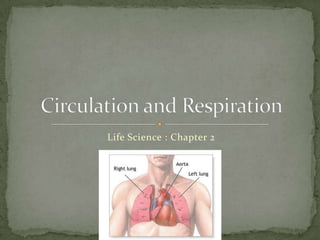Life Science 2.1 : The Cardiovascular System
•Download as PPTX, PDF•
2 likes•2,268 views
Report
Share
Report
Share

Recommended
Recommended
More Related Content
Viewers also liked
Viewers also liked (17)
Introduction to Science 3.1 : Exploring Physical Science

Introduction to Science 3.1 : Exploring Physical Science
Chapter 20.3 : Saturated and Unsaturated Hydrocarbons

Chapter 20.3 : Saturated and Unsaturated Hydrocarbons
More from Chris Foltz
More from Chris Foltz (20)
Earth Science 3.3 : Absolute Dating: A Measure of Time

Earth Science 3.3 : Absolute Dating: A Measure of Time
Earth Science 3.1 : Earth's Story and Those Who First Listened.

Earth Science 3.1 : Earth's Story and Those Who First Listened.
Earth Science 3.2 : Relative Dating : Which Came First?

Earth Science 3.2 : Relative Dating : Which Came First?
Recently uploaded
Model Call Girl in Bikash Puri Delhi reach out to us at 🔝9953056974🔝

Model Call Girl in Bikash Puri Delhi reach out to us at 🔝9953056974🔝9953056974 Low Rate Call Girls In Saket, Delhi NCR
Organic Name Reactions for the students and aspirants of Chemistry12th.pptx

Organic Name Reactions for the students and aspirants of Chemistry12th.pptxVS Mahajan Coaching Centre
“Oh GOSH! Reflecting on Hackteria's Collaborative Practices in a Global Do-It...

“Oh GOSH! Reflecting on Hackteria's Collaborative Practices in a Global Do-It...Marc Dusseiller Dusjagr
Recently uploaded (20)
Call Girls in Dwarka Mor Delhi Contact Us 9654467111

Call Girls in Dwarka Mor Delhi Contact Us 9654467111
Presentation by Andreas Schleicher Tackling the School Absenteeism Crisis 30 ...

Presentation by Andreas Schleicher Tackling the School Absenteeism Crisis 30 ...
A Critique of the Proposed National Education Policy Reform

A Critique of the Proposed National Education Policy Reform
Model Call Girl in Bikash Puri Delhi reach out to us at 🔝9953056974🔝

Model Call Girl in Bikash Puri Delhi reach out to us at 🔝9953056974🔝
TataKelola dan KamSiber Kecerdasan Buatan v022.pdf

TataKelola dan KamSiber Kecerdasan Buatan v022.pdf
Organic Name Reactions for the students and aspirants of Chemistry12th.pptx

Organic Name Reactions for the students and aspirants of Chemistry12th.pptx
Science 7 - LAND and SEA BREEZE and its Characteristics

Science 7 - LAND and SEA BREEZE and its Characteristics
“Oh GOSH! Reflecting on Hackteria's Collaborative Practices in a Global Do-It...

“Oh GOSH! Reflecting on Hackteria's Collaborative Practices in a Global Do-It...
Introduction to ArtificiaI Intelligence in Higher Education

Introduction to ArtificiaI Intelligence in Higher Education
Life Science 2.1 : The Cardiovascular System
- 1. Life Science : Chapter 2 Circulation and Respiration
- 2. Life Science : 2.1 The Cardiovascular System
- 3. Objectives: Listfive main parts of the cardiovascular system, and describe their functions. Describe the two types of circulation of blood in the body. List four cardiovascular problems.
- 4. Your Cardiovascular System The cardiovascular systemconsists of : The heart and the three types of blood vessels that carry blood throughout your body. The blood vessels Arteries Capillaries Veins Carry blood pumped by the heart.
- 5. The Heart Cardiac Muscle Your heart is an organ made mostly of cardiac muscle tissue. It is about the size of your fist and is almost in the center of your chest cavity.
- 7. Blood Vessels Arteries Blood vessels that carry blood away from the heart and to the body’s organs. Capillaries Tiny blood vessels that allow the exchange between body cells and blood. Veins Blood vessels that carry blood back to the heart.
- 8. Two Types of Circulation Pulmonary circulation The flow of blood from the heart to the lungs and back to the heart through the pulmonary arteries, capillaries, and veins. Systemic circulation The flow of blood from the heart to all parts of the body and back to the heart.
- 10. Cardiovascular Problems Atherosclerosis Happens when cholesterol builds up inside of the blood vessels. Major cause of heart diseases.
- 11. High Blood Pressure Hypertension Abnormally high blood pressure. The higher the blood pressure, the greater the risk of a heart attack, heart failure, kidney disease, and stroke. Heart Attacks and Heart Failure A heart attack happens when heart muscle cells die and part of the heart muscle is damaged. Heart failure happens when the heart cannot pump enough blood to meet the body’s needs.